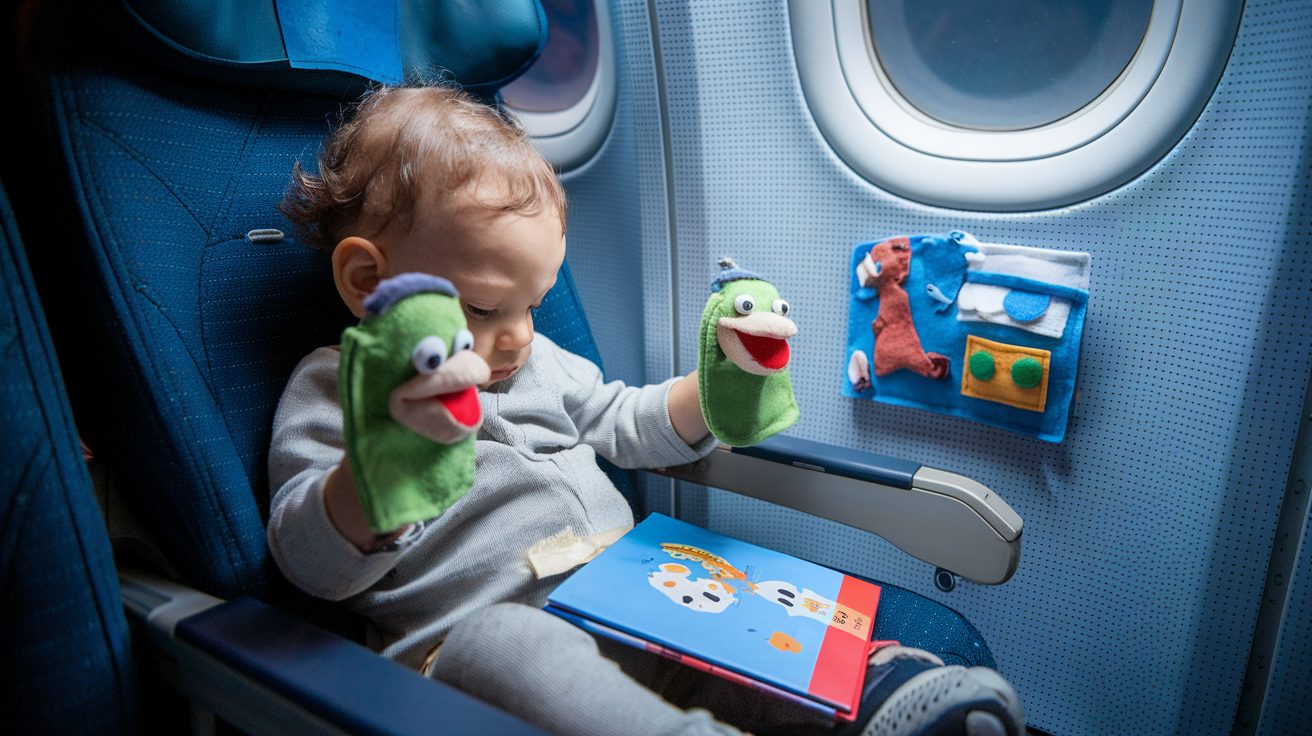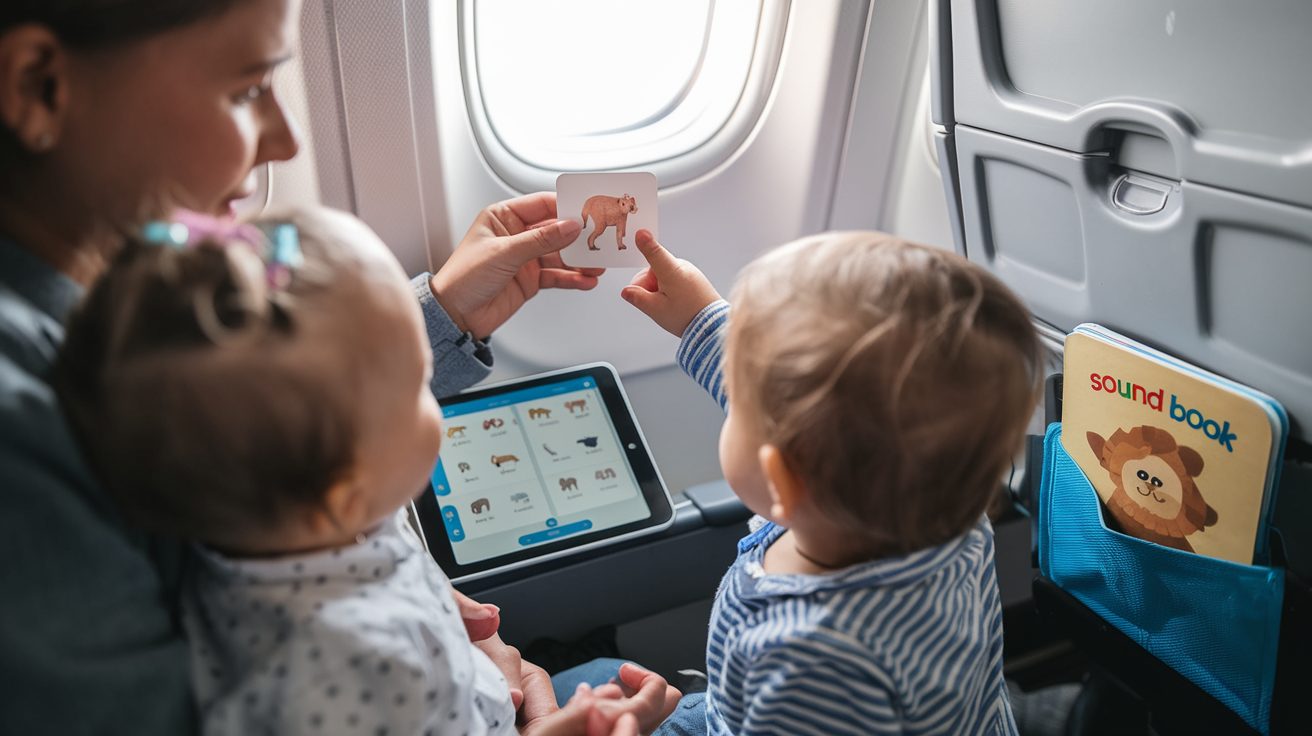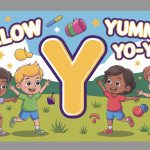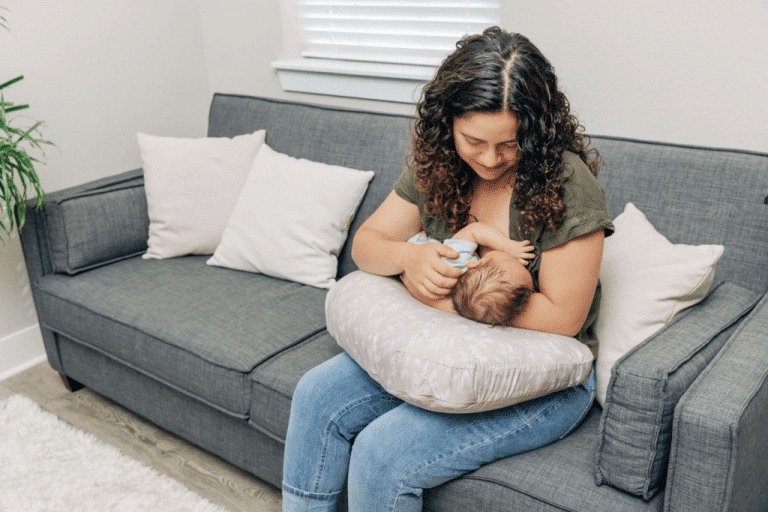Flying with toddlers strikes fear into even the most seasoned parents—the confined space, the inability to run free, and the dreaded meltdown potential.
But with strategic planning, your flight can shift from survival mode to genuine enjoyment.
This collection of airplane activities specifically tackles the challenges of entertaining 1-3-year-olds at 30,000 feet.
These aren’t just generic kids’ activities—they’re tailored for the limited space, noise considerations, and attention spans of toddlers in flight.
From mess-free art options to sensory play that fits on a tray table, we’ve tested these ideas through turbulence and tired tantrums.
Pack these parent-proven activities in your carry-on, and watch your little one stay engaged while fellow passengers breathe sighs of relief. Air travel with toddlers doesn’t have to be the nightmare everyone warns about.
How to Prepare for the Trip
Success with toddlers in the air begins before you ever board the plane. Taking time to understand and anticipate their needs can make all the difference.
Understanding Your Toddler’s Needs
Toddlers aren’t simply small adults – they process travel differently, with shorter attention spans and a greater need for physical activity.
Before selecting activities, consider your child’s specific temperament.
Is your little one drawn to tactile experiences? Do they prefer familiar objects or get excited by novelty? Are they morning-energetic but afternoon-drowsy?
Matching activities to your child’s natural rhythms and preferences increases your chances of a smoother flight.
Remember that most toddlers can focus on a single activity for roughly 2-5 minutes per year of age, so plan to rotate through options frequently.
Strategic Packing
Organization becomes your greatest ally when flying with toddlers. Consider these strategic packing approaches:
- Use clear zip-top bags to separate activities by type (art supplies in one, small toys in another)
- Create individual activity packets that contain everything needed for one activity
- Pack a “surprise bag” with new items to be revealed only when necessary
- Keep essentials (snacks, wipes, favorite comfort item) in an easily accessible outer pocket
- Consider using a hanging organizer that attaches to the seat back to keep activities visible and within reach
This systematic approach prevents the frustrating digging through bags mid-flight and helps you quickly access the perfect activity when you need it most.
Creative & Mess-Free Art Activities
1. Color Wonder Markers and Paper
Age Group: 2-3 years
Materials Needed: Crayola Color Wonder markers, Color Wonder paper
Step-by-Step Instructions:
- Pack Color Wonder markers and special paper in a ziplock bag.
- Give your toddler one marker at a time to prevent dropping.
- Show them how the “magic” works by making a mark on the special paper.
- Rotate marker colors throughout the flight to maintain interest.
| Benefits | Mess-free, won’t mark clothes or tray tables |
| Duration | 10-15 minutes |
| Tips for Engagement | Bring paper with outlines of favorite characters |
| Safety Considerations | Non-toxic, cap may be a choking hazard |
| Variations | Travel-sized sets available with smaller paper |
Why Toddlers Love It: The “magical” appearance of colors on blank paper creates an exciting cause-effect experience that feels like a special power.
2. Reusable Sticker Books
Age Group: 2-3 years
Materials Needed: Reusable vinyl sticker books with scenes
Step-by-Step Instructions:
- Introduce the sticker book by showing the scene pages first.
- Demonstrate how stickers can be placed and peeled off repeatedly.
- Start with just a few stickers for younger toddlers to manage.
- Create simple “find and place” games like “put the dog near the tree.”
| Benefits | Develops fine motor skills, no mess, reusable |
| Duration | 15-20 minutes |
| Tips for Engagement | Narrate stories about the stickers’ placement |
| Safety Considerations | Supervise to prevent putting stickers in mouth |
| Variations | Melissa & Doug, Usborne, and Sassafras offer different themes |
Why Toddlers Love It: The tactile satisfaction of peeling and sticking combines with the power of controlling where things go.
3. Water Reveal Pads
Age Group: 2-3 years
Materials Needed: Water reveal coloring books, water pen
Step-by-Step Instructions:
- Fill the special water pen before boarding (only partially to prevent leaks).
- Show your toddler how colors or pictures appear when the pen touches the page.
- Let them experiment with making marks on different parts of the page.
- When the page dries, it can be used again, extending the activity’s lifespan.
| Benefits | No mess, reusable as it dries, airplane-friendly |
| Duration | 15-25 minutes |
| Tips for Engagement | Ask questions about what they’re revealing |
| Safety Considerations | No choking hazards if pen cap is secured |
| Variations | Water Wow! pads, Aquadoodle books, Crayola Color Wonder Water Books |
Why Toddlers Love It: The magical reveal effect of hidden pictures appearing feels like a special trick only they can perform.
4. Magnetic Drawing Board
Age Group: 2-3 years
Materials Needed: Travel-sized magnetic drawing board with attached stylus
Step-by-Step Instructions:
- Secure the drawing board on the tray table or child’s lap.
- Show how the stylus creates lines and the slider erases them.
- Take turns drawing simple shapes or lines for your toddler to copy.
- Create a game of “guess what I’m drawing” for older toddlers.
| Benefits | Completely mess-free, reusable, develops fine motor skills |
| Duration | 10-20 minutes |
| Tips for Engagement | Draw outlines of simple objects for them to complete |
| Safety Considerations | Ensure stylus is securely attached |
| Variations | Mini versions available with finger-sized stylus |
Why Toddlers Love It: The immediate visual feedback combined with the satisfying sensation of making marks attracts toddlers, while the instant-erase feature prevents frustration.
5. Flip Books with Moving Tabs
Age Group: 1-3 years
Materials Needed: Interactive board books with pull tabs, flaps, or sliding elements
Step-by-Step Instructions:
- Select books with sturdy mechanisms that won’t tear easily.
- Demonstrate how to gently pull tabs or lift flaps.
- Create anticipation by asking “What do you think is behind this flap?”
- Let your toddler take the lead once they understand how the book works.
| Benefits | Builds fine motor skills while encouraging focus and prediction |
| Duration | 10-15 minutes |
| Tips for Engagement | Use exaggerated surprise reactions when discovering hidden elements |
| Safety Considerations | Reinforced tabs hold up better to enthusiastic handling |
| Variations | Books with textured elements add sensory engagement |
Why Toddlers Love It: The immediate cause-and-effect relationship of moving a tab and seeing the result satisfies toddlers’ curiosity.
6. Crayon Rolls with Mini Coloring Pages
Age Group: 2-3 years
Materials Needed: Fabric crayon roll with 5-6 crayons, small coloring sheets
Step-by-Step Instructions:
- Pack a crayon roll with individually secured crayons to prevent dropping.
- Bring quarter-page sized coloring sheets rather than full books.
- Demonstrate coloring within a small area first.
- Offer just 1-2 pages at a time to prevent overwhelm.
| Benefits | Develops fine motor control and color recognition |
| Duration | 10-15 minutes |
| Tips for Engagement | Create simple challenges like “Can you find all the blue spots?” |
| Safety Considerations | Triangle or egg-shaped crayons won’t roll off tray tables |
| Variations | Water-reveal coloring books eliminate crayon concerns entirely |
Why Toddlers Love It: The familiar activity provides comfort while the special travel-sized materials make it feel like a unique experience.
7. Roll-up Chalkboard Mat
Age Group: 2-3 years
Materials Needed: Travel-sized fabric chalkboard mat, dustless chalk
Step-by-Step Instructions:
- Spread mat flat on tray table or lap.
- Show how to draw with chalk and erase with attached cloth.
- Start with simple mark-making or tracing shapes.
- Roll up and secure with attached tie between uses.
| Benefits | Provides drawing practice with minimal dust and easy storage |
| Duration | 10-15 minutes |
| Tips for Engagement | Play simple games like tic-tac-toe or connect dots |
| Safety Considerations | Use dustless chalk to minimize mess; wipe hands after use |
| Variations | Some mats feature printed outlines or games for added engagement |
Why Toddlers Love It: The novelty of chalk compared to regular crayons creates interest, while the roll-up design feels special and different.
8. Mini Whiteboard with Marker
Age Group: 2-3 years
Materials Needed: Small whiteboard with attached marker, cleaning cloth
Step-by-Step Instructions:
- Pack a compact whiteboard with marker securely attached by string.
- Demonstrate drawing simple shapes or lines.
- Show how to erase with the cloth when board gets full.
- Play games like taking turns adding to a drawing or playing tic-tac-toe.
| Benefits | Develops pre-writing skills with renewable drawing surface |
| Duration | 10-15 minutes |
| Tips for Engagement | Trace your toddler’s hand or draw simple pictures for them to identify |
| Safety Considerations | Use low-odor markers; keep cap attached when not in use |
| Variations | Double-sided versions offer more drawing space |
Why Toddlers Love It: The ability to create and erase repeatedly encourages experimentation without fear of mistakes.
9. Dry-erase Activity Boards
Age Group: 2-3 years
Materials Needed: Small dry-erase board with attached marker, simple activity cards
Step-by-Step Instructions:
- Pack a board with marker securely attached by string.
- Bring 2-3 simple activity cards with traceable lines or shapes.
- Demonstrate how to make marks and erase with tissue or cloth.
- Encourage free drawing between structured activities.
| Benefits | Develops pre-writing skills and hand control with erasable mistakes |
| Duration | 10-15 minutes |
| Tips for Engagement | Take turns drawing something for the other to guess |
| Safety Considerations | Low-odor markers are best; keep caps secured when not in use |
| Variations | Magnetic drawing alternatives eliminate marker concerns |
Why Toddlers Love It: The ability to create and erase repeatedly without consequence encourages experimentation and reduces frustration.
Sensory & Fine Motor Skill Builders
10. Threading Beads on Pipe Cleaners
Age Group: 2-3 years
Materials Needed: Large wooden or plastic beads, pipe cleaners
Step-by-Step Instructions:
- Bend one end of pipe cleaner to prevent beads from falling off.
- Demonstrate how to thread beads onto the straight end.
- Offer a small container of large beads to select from.
- Create patterns using different colored beads for older toddlers.
| Benefits | Develops fine motor coordination and focus |
| Duration | 10-15 minutes |
| Tips for Engagement | Create a “necklace” or “snake” story while threading |
| Safety Considerations | Use beads larger than 1 inch diameter; keep pipe cleaner ends tucked |
| Variations | Pony beads for older children; foam beads for quieter play |
Why Toddlers Love It: The satisfying sensation of successfully threading beads provides immediate accomplishment and visual progress.
11. Lacing Cards
Age Group: 2-3 years
Materials Needed: Premade lacing cards, thick shoelace or yarn with taped end
Step-by-Step Instructions:
- Pack 2-3 different lacing cards with colorful designs.
- Secure one end of the lace to the card to prevent it from pulling through.
- Demonstrate simple in-and-out threading motions.
- Encourage your toddler to create any pattern, not just following holes in order.
| Benefits | Develops fine motor skills, hand-eye coordination, and concentration |
| Duration | 10-15 minutes |
| Tips for Engagement | Use cards with familiar objects or characters |
| Safety Considerations | Ensure lace ends are secured with tape to prevent fraying |
| Variations | DIY versions can be made with cardboard and hole puncher |
Why Toddlers Love It: The repetitive threading motion provides a calming, focused activity with visible progress that toddlers can control.
12. Velcro Craft Kits
Age Group: 2-3 years
Materials Needed: Premade sets with Velcro-backed pieces and base board
Step-by-Step Instructions:
- Choose age-appropriate kits with large, simple pieces.
- Demonstrate the satisfying “stick” of Velcro attachments.
- Start with a theme like making a face or building a vehicle.
- Allow free creation rather than following a specific pattern.
| Benefits | Encourages creativity while developing fine motor skills |
| Duration | 15-20 minutes |
| Tips for Engagement | Name colors and shapes as your toddler selects them |
| Safety Considerations | Ensure pieces are large enough to prevent choking hazards |
| Variations | DIY kits can be made with Velcro dots and felt shapes |
Why Toddlers Love It: The distinctive Velcro sound and sensation provides immediate feedback that pieces are correctly placed.
13. Sensory Bags
Age Group: 1-3 years
Materials Needed: Premade or DIY sealed bags with colored gel/liquid and small objects
Step-by-Step Instructions:
- Create or purchase double-sealed bags filled with hair gel and small objects.
- Secure edges with strong packing tape for flight safety.
- Show how to press and move objects through the gel.
- Create games like “Can you find the star?”
| Benefits | Provides sensory stimulation and visual tracking practice |
| Duration | 10-15 minutes |
| Tips for Engagement | Use themed items like ocean creatures or alphabet letters |
| Safety Considerations | Triple-check seals before flight; keep away from sharp objects |
| Variations | Dry sensory bags with rice or beans offer different sensory feedback |
Why Toddlers Love It: The squishing sensation combined with visual hunt activities creates a focused sensory experience without mess.
14. Pop Tubes
Age Group: 1-3 years
Materials Needed: Expandable plastic pop tubes (sensory toy)
Step-by-Step Instructions:
- Pack 2-3 pop tubes of different colors in a ziplock bag.
- Demonstrate how they expand, contract, and make popping sounds.
- Show how tubes can connect together to make longer tubes.
- Create shapes like circles or letters for older toddlers.
| Benefits | Provides sensory input, fine motor practice, and cause-effect learning |
| Duration | 10-15 minutes |
| Tips for Engagement | Whisper into one end and listen from the other |
| Safety Considerations | Use under supervision to prevent tangling or squeezing too hard |
| Variations | Mini versions available that make less noise for airplane use |
Why Toddlers Love It: The satisfying sensory feedback—both tactile and auditory—creates an engaging experience that feels slightly mischievous.
15. Suction Cup Toys
Age Group: 1-3 years
Materials Needed: Small toys with suction cup bases
Step-by-Step Instructions:
- Pack 3-4 toys with strong suction cup bases.
- Demonstrate pressing firmly on window or tray table to attach.
- Show how to pull to remove and reposition.
- Create games like moving characters through an imaginary story.
| Benefits | Develops fine motor strength while preventing dropped toys |
| Duration | 10-15 minutes |
| Tips for Engagement | Create a story about the characters traveling on the plane |
| Safety Considerations | Test suction strength before flight; clean surfaces first for better stick |
| Variations | Character-based options cater to specific interests |
Why Toddlers Love It: The stability of secured toys provides control in the unfamiliar plane environment, while the suction/release action is satisfying.
16. Stretchy Fidget Strings
Age Group: 2-3 years
Materials Needed: Silicone or rubber stretchy strings in various colors
Step-by-Step Instructions:
- Pack 2-3 colorful stretchy strings in a small container.
- Demonstrate safe stretching techniques without snapping.
- Show how to wrap around fingers or make simple shapes.
- Create loops or figures like circles and figure-eights.
| Benefits | Provides sensory input and fine motor practice with minimal noise |
| Duration | 10-15 minutes |
| Tips for Engagement | Create challenges like “Can you make a triangle?” |
| Safety Considerations | Choose thicker strings that won’t break easily; supervise to prevent tangling |
| Variations | Some strings feature different textures or subtle differences in stretchiness |
Why Toddlers Love It: The resistance and stretch sensation provides calming proprioceptive input that many toddlers find regulating.
17. Sensory Balls or Squishy Toys
Age Group: 1-3 years
Materials Needed: Small textured balls or squishy toys
Step-by-Step Instructions:
- Pack 2-3 different textured sensory balls or squishies.
- Demonstrate squeezing, rolling, or examining textures.
- Create simple games like rolling back and forth on the tray table.
- Name sensations: “This one is bumpy!” or “This feels squishy!”
| Benefits | Provides sensory input and hand strengthening in a compact form |
| Duration | 5-10 minutes |
| Tips for Engagement | Hide a small ball in your hand for a simple guessing game |
| Safety Considerations | Choose washable materials without small parts |
| Variations | Balls with different fillings offer various resistance levels |
Why Toddlers Love It: The tactile stimulation helps regulate sensory input during the overwhelming experience of flying.
18. Soft Activity Cubes
Age Group: 1-3 years
Materials Needed: Fabric cube with different activities on each side
Step-by-Step Instructions:
- Choose a cube with a variety of textures and simple interactive elements.
- Introduce one side at a time, demonstrating each feature.
- Allow exploration of buckles, zippers, or textures at child’s pace.
- Name colors, shapes, and actions as your toddler engages with the cube.
| Benefits | Provides multiple sensory experiences in one compact toy |
| Duration | 10-20 minutes |
| Tips for Engagement | Create simple challenges like “Can you find something red?” |
| Safety Considerations | Ensure all attachments are securely sewn; supervise play |
| Variations | Themed cubes available with specific skills or concepts |
Why Toddlers Love It: Every side offers a different activity, providing variety without overwhelming with too many separate toys.
Puzzle & Problem-Solving Fun
19. Magnetic Puzzles
Age Group: 2-3 years
Materials Needed: Travel magnetic puzzle with contained pieces
Step-by-Step Instructions:
- Choose a puzzle with 5-10 large pieces for younger toddlers.
- Show how pieces stick to the magnetic board.
- Start by removing only 1-2 pieces, then work up to the full puzzle.
- Create simple challenges like “Find the red piece” or “Where does the dog go?”
| Benefits | Develops spatial awareness and problem-solving skills |
| Duration | 10-15 minutes |
| Tips for Engagement | Name each piece and its position to build vocabulary |
| Safety Considerations | Select puzzles with pieces too large to swallow |
| Variations | Layered puzzles for older toddlers; simple shapes for younger ones |
Why Toddlers Love It: The satisfying click of magnetic pieces provides immediate feedback and success, even when tiny hands are still developing coordination.
20. Puzzle Books
Age Group: 2-3 years
Materials Needed: Board books with simple puzzles built into pages
Step-by-Step Instructions:
- Select books with 2-5 piece puzzles embedded in sturdy pages.
- Show how puzzle pieces fit in specific spots on each page.
- Read the story first, then focus on completing puzzles.
- For younger toddlers, remove only one piece at a time.
| Benefits | Combines literacy with problem-solving and fine motor skills |
| Duration | 10-15 minutes |
| Tips for Engagement | Relate puzzle images to real things your child recognizes |
| Safety Considerations | Choose books with firmly attached puzzle pieces |
| Variations | Options range from simple shapes to more complex scenes |
Why Toddlers Love It: The combination of familiar stories with the satisfaction of completing puzzles creates an engaging multi-sensory experience.
21. Puzzle Cubes
Age Group: 2-3 years
Materials Needed: Simple 2×2 or 3×3 puzzle cube with large pieces
Step-by-Step Instructions:
- Select a cube with 4-9 large pieces that create complete pictures.
- Show how pieces rotate to align different images.
- Start with aligning just one row or side before attempting full puzzles.
- Point out how pictures connect across pieces.
| Benefits | Develops spatial reasoning and problem-solving skills |
| Duration | 10-15 minutes |
| Tips for Engagement | Focus on the process rather than solving the entire puzzle |
| Safety Considerations | Choose cubes with rounded edges and secure construction |
| Variations | Photo cubes with family pictures provide personalized engagement |
Why Toddlers Love It: The transformative nature of the changing pictures creates an element of surprise with each turn.
22. Stacking Cups
Age Group: 1-3 years
Materials Needed: Nesting/stacking cups (plastic or silicone)
Step-by-Step Instructions:
- Pack a set of 5-8 stacking cups that nest for compact storage.
- Demonstrate building a tower by stacking largest to smallest.
- Show how cups can nest inside each other for storage.
- Create games like hiding small toys under cups or sorting by color.
| Benefits | Teaches spatial relationships, size sequencing, and cause-effect |
| Duration | 10-15 minutes |
| Tips for Engagement | Count cups as you stack or create dramatic tower collapses |
| Safety Considerations | Soft silicone cups are safest for youngest toddlers |
| Variations | Some sets include holes for water play (best saved for after the flight!) |
Why Toddlers Love It: The versatility of stacking, nesting, and knocking down provides multiple play patterns that satisfy different developmental urges.
23. Fabric or Plastic Stacking Rings
Age Group: 1-3 years
Materials Needed: Compact stacking ring set with 4-6 rings
Step-by-Step Instructions:
- Select a set with a stable base that won’t tip easily.
- Demonstrate placing rings from largest to smallest.
- Mix up the rings and encourage your toddler to try stacking.
- Create variations like stacking in reverse or alternating colors.
| Benefits | Teaches size sequencing, fine motor control, and spatial relationships |
| Duration | 10-15 minutes |
| Tips for Engagement | Name each color and size as rings are stacked |
| Safety Considerations | Fabric or soft plastic versions are quieter and safer |
| Variations | Some sets feature textured rings or rings that make subtle sounds |
Why Toddlers Love It: The clear goal with visible progress creates a satisfying activity with definite completion.
24. Simple Shape Sorters
Age Group: 1-3 years
Materials Needed: Compact shape sorter with 3-5 basic shapes
Step-by-Step Instructions:
- Choose a shape sorter with large, easy-to-grip pieces.
- Introduce shapes one at a time, naming each one.
- Show how each shape fits through its matching opening.
- For younger toddlers, start with the circular opening which is easiest.
| Benefits | Teaches shape recognition, problem-solving, and persistence |
| Duration | 10-15 minutes |
| Tips for Engagement | Create excitement when shapes fall through with “Whee!” or “It worked!” |
| Safety Considerations | Select sorters with pieces too large to swallow |
| Variations | Travel versions with fabric pouches instead of hard containers are quieter |
Why Toddlers Love It: The clear success/failure feedback helps toddlers learn through trial and error with immediate results.
25. Clip-and-Snap Toys
Age Group: 2-3 years
Materials Needed: Set of connecting plastic shapes that snap together
Step-by-Step Instructions:
- Bring 15-20 pieces in a small container or bag.
- Demonstrate how pieces connect and disconnect.
- Start by making a simple chain or circle.
- For older toddlers, suggest creating specific objects like flowers or faces.
| Benefits | Builds fine motor strength, hand coordination, and spatial thinking |
| Duration | 15-20 minutes |
| Tips for Engagement | Create a challenge of connecting all pieces into one structure |
| Safety Considerations | Choose pieces large enough to prevent choking hazards |
| Variations | Some sets feature animals or vehicles that appeal to specific interests |
Why Toddlers Love It: The satisfying click of pieces connecting provides immediate feedback and success, encouraging continued exploration.
26. Zipper Pouch Sorting Games
Age Group: 2-3 years
Materials Needed: Small zippered pouches, sets of sorted items (buttons, pom-poms)
Step-by-Step Instructions:
- Create sorting collections with 2-3 categories (by color or shape).
- Mix items together in one container.
- Label zippered pouches with colors or pictures showing what goes inside.
- Demonstrate sorting one of each type into correct pouches.
| Benefits | Develops categorization skills, color recognition, and fine motor control |
| Duration | 10-15 minutes |
| Tips for Engagement | Count items as they’re sorted; compare which group has more |
| Safety Considerations | Use items larger than 1 inch for younger toddlers |
| Variations | Themed sorting (animals to habitats, shapes to matching cards) |
Why Toddlers Love It: The systematic organization appeals to toddlers’ developing sense of order while zippered pouches add a practical life skill.
Imaginative & Pretend Play
27. Finger Puppets
Age Group: 1-3 years
Materials Needed: Set of soft finger puppets (animals, people, or characters)
Step-by-Step Instructions:
- Introduce puppets one at a time, demonstrating how they fit on fingers.
- Create simple interactions between puppets (like greeting each other).
- Use different voices for each character.
- Encourage your toddler to place puppets on their own fingers when ready.
| Benefits | Stimulates imagination, language development, and storytelling |
| Duration | 10-20 minutes |
| Tips for Engagement | Incorporate familiar scenarios like bedtime or mealtime |
| Safety Considerations | Choose washable puppets without small detachable parts |
| Variations | Paper finger puppets can be colored during flight then played with |
Why Toddlers Love It: Finger puppets transform parent and child into storytellers, giving toddlers control over a miniature world.
28. Busy Board
Age Group: 1-3 years
Materials Needed: Travel-sized busy board with zippers, buttons, latches
Step-by-Step Instructions:
- Choose a compact busy board with securely attached elements.
- Introduce one feature at a time to prevent overwhelm.
- Demonstrate how each element works, then let your toddler try.
- Create simple challenges like “Can you open all the zippers?”
| Benefits | Teaches practical life skills while keeping hands busy |
| Duration | 15-25 minutes |
| Tips for Engagement | Name each action as your child performs it to build vocabulary |
| Safety Considerations | Ensure all parts are firmly attached with no small detachable pieces |
| Variations | Travel versions fold up compactly; fabric options are quieter |
Why Toddlers Love It: Busy boards simulate adult actions toddlers observe daily, satisfying their desire to mimic parents’ behaviors.
29. Mini Felt Play Sets
Age Group: 2-3 years
Materials Needed: Portable felt board with themed felt pieces (farm, vehicles, etc.)
Step-by-Step Instructions:
- Pack a small felt board with themed felt pieces in a zip pouch.
- Introduce the theme and characters before starting play.
- Show how pieces stick to the board and can be moved around.
- Begin with a simple story prompt like “The cat is looking for a place to sleep.”
| Benefits | Encourages storytelling, creativity, and quiet imaginative play |
| Duration | 15-20 minutes |
| Tips for Engagement | Take turns adding pieces to collaborate on a story |
| Safety Considerations | Use larger felt pieces for younger toddlers |
| Variations | DIY sets can be made with specific interests like favorite books |
Why Toddlers Love It: The open-ended nature allows children to create and change scenes at will, providing control over their own stories.
30. Pretend Play Sets (Mini Version)
Age Group: 2-3 years
Materials Needed: Compact themed play set (doctor kit, kitchen tools, etc.)
Step-by-Step Instructions:
- Select a small set with 5-6 themed items that fit in a pouch.
- Introduce the theme and demonstrate each item’s purpose.
- Invite pretend play scenarios appropriate to the theme.
- Incorporate stuffed animals or finger puppets as “patients” or “diners.”
| Benefits | Encourages imagination, role-playing, and storytelling |
| Duration | 15-20 minutes |
| Tips for Engagement | Take on a character role yourself to extend the play scenario |
| Safety Considerations | Choose sets with larger pieces and no sharp edges |
| Variations | DIY sets in mint tins or small containers can be customized to interests |
Why Toddlers Love It: Miniature versions of adult tools satisfy toddlers’ desire to mimic grown-up activities in a manageable, toddler-sized way.
31. Story Dice (Roll and Make a Story)
Age Group: 2-3 years
Materials Needed: Soft fabric or foam dice with pictures on each side
Step-by-Step Instructions:
- Pack 2-3 story dice in a small container.
- Demonstrate rolling one die and identifying the picture.
- Make up a simple sentence about the picture that appears.
- For older toddlers, roll multiple dice and connect the pictures in a story.
| Benefits | Develops language skills, creativity, and narrative thinking |
| Duration | 10-15 minutes |
| Tips for Engagement | Take turns adding to the story with each new roll |
| Safety Considerations | Soft foam or fabric dice won’t make noise when rolling |
| Variations | Themed dice sets (animals, actions, places) create different story types |
Why Toddlers Love It: The element of chance creates excitement while the storytelling builds confidence in language use.
32. DIY Photo Book of Family Faces
Age Group: 1-3 years
Materials Needed: Small photo album with familiar faces, secured photos
Step-by-Step Instructions:
- Create a small book with 5-10 photos of familiar people or pets.
- Laminate or secure photos to prevent removal during travel.
- Label each photo with the person’s name and relationship.
- Ask “Who’s this?” or “Where’s Grandma?” as you look through together.
| Benefits | Provides emotional connection to family during travel |
| Duration | 5-10 minutes |
| Tips for Engagement | Add simple phrases or memories with each photo |
| Safety Considerations | Use durable materials that can withstand handling |
| Variations | Theme-based versions showing favorite places or activities |
Why Toddlers Love It: Recognizing familiar faces creates comfort and security during the unfamiliar experience of flying, while practicing naming loved ones builds confidence and connection.
Learning & Travel-Friendly Flash Fun
33. Magnetic Play Scenes
Age Group: 2-3 years
Materials Needed: Magnetic board with themed character pieces
Step-by-Step Instructions:
- Pack a compact magnetic board with 8-10 themed pieces.
- Introduce the scene theme (farm, vehicles, etc.) before adding pieces.
- Demonstrate how pieces stick to the board and can be repositioned.
- Create simple story prompts to encourage imaginative play.
| Benefits | Encourages storytelling and imaginative play without pieces falling |
| Duration | 15-20 minutes |
| Tips for Engagement | Take turns adding pieces and building on the story |
| Safety Considerations | Choose sets with pieces too large to swallow |
| Variations | Travel-sized options include fold-up cases that become the play surface |
Why Toddlers Love It: The combination of storytelling freedom with pieces that stay put creates an ideal plane activity with minimal frustration.
34. Quiet Books (Fabric-based)
Age Group: 1-3 years
Materials Needed: Fabric book with interactive elements on each page
Step-by-Step Instructions:
- Select books with age-appropriate fasteners and activities.
- Introduce one page at a time, demonstrating each activity.
- Allow plenty of time for mastering each page before moving on.
- Gradually let your toddler explore independently as they learn.
| Benefits | Develops fine motor skills through various fastening activities |
| Duration | 15-25 minutes |
| Tips for Engagement | Narrate activities using action words and descriptive language |
| Safety Considerations | Check for securely sewn elements before each use |
| Variations | Themed books available from simple skills to advanced challenges |
Why Toddlers Love It: Each page offers a new challenge and skill to master, providing a sense of accomplishment and progressive difficulty.
Learning & Travel-Friendly Flash Fun
35. Interactive Sound Books
Age Group: 2-3 years
Materials Needed: Interactive sound books with buttons
Step-by-Step Instructions:
- Choose books with volume control to be considerate of other passengers.
- Pre-set the volume to low before offering to your toddler.
- Start by reading the story, pointing to buttons when appropriate.
- Gradually let your toddler take control of pressing buttons as they learn the story.
| Benefits | Multi-sensory engagement, familiar stories provide comfort |
| Duration | 10-15 minutes |
| Tips for Engagement | Use headphones for older toddlers on longer flights |
| Safety Considerations | Check battery compartment is secure |
| Variations | Look for options with textures or lift-the-flap features |
Why Toddlers Love It: The power to create sounds by pushing buttons gives toddlers a sense of control and cause-effect understanding that’s deeply satisfying.
36. Flashcards with Animals or Shapes
Age Group: 1-3 years
Materials Needed: Set of sturdy flashcards with simple, bold images
Step-by-Step Instructions:
- Pack 10-15 cards with familiar objects, animals, or shapes.
- Present cards one at a time, naming each image clearly.
- For older toddlers, ask “What’s this?” before offering the answer.
- Create games like finding all the animals or matching colors.
| Benefits | Builds vocabulary and recognition while providing focused activity |
| Duration | 5-10 minutes |
| Tips for Engagement | Make animal sounds or shape motions to increase interest |
| Safety Considerations | Rounded-corner cards prevent paper cuts |
| Variations | Ring-bound cards prevent loss; double-sided cards offer more content |
Why Toddlers Love It: The predictable pattern of viewing and naming creates a comfortable rhythm that toddlers find reassuring.
37. Ring Flashcards on a Clip
Age Group: 1-3 years
Materials Needed: Set of flashcards connected by metal or plastic ring
Step-by-Step Instructions:
- Select cards featuring age-appropriate content (animals, colors, shapes).
- Clip the ring to stroller or bag when not in use to prevent loss.
- Show how to flip through cards one at a time.
- Name each image clearly, then ask older toddlers to identify them.
| Benefits | Builds vocabulary while providing contained, organized activity |
| Duration | 5-10 minutes |
| Tips for Engagement | Add sound effects or movements for each card |
| Safety Considerations | Choose cards with rounded corners and durable material |
| Variations | First words, counting, or thematic sets available for different interests |
Why Toddlers Love It: The predictable pattern of viewing and naming creates a comforting routine that toddlers can control.
38. Playdough (Travel-sized)
Age Group: 2-3 years
Materials Needed: Small containers of playdough, 1-2 simple tools
Step-by-Step Instructions:
- Bring mini containers (party favor size) to limit mess.
- Place a napkin or air sickness bag as a clean work surface.
- Demonstrate simple techniques like rolling balls or snakes.
- Include one tool like a plastic knife or cookie cutter for variety.
| Benefits | Provides sensory input while developing hand strength and creativity |
| Duration | 15-20 minutes |
| Tips for Engagement | Create simple challenges like “Can you make a tiny pizza?” |
| Safety Considerations | Keep away from upholstery; supervise to prevent eating |
| Variations | Homemade versions can be made less sticky for travel |
Why Toddlers Love It: The malleable texture provides deep sensory satisfaction while offering unlimited creative possibilities.
39. Snack Sorting Games
Age Group: 2-3 years
Materials Needed: Small container with dividers, colorful sorted snacks
Step-by-Step Instructions:
- Pack a compartment container with mixed colorful snacks.
- Show how to sort items by color, shape, or type.
- Create a game of picking specific colors or counting pieces.
- Allow eating sorted snacks as a reward for completion.
| Benefits | Combines fine motor practice with cognitive skills and snack time |
| Duration | 15-20 minutes |
| Tips for Engagement | Use snacks that won’t stain if dropped (cereal, crackers) |
| Safety Considerations | Always supervise eating; choose age-appropriate non-choking hazards |
| Variations | Use silicone muffin cups for temporary sorting containers |
Why Toddlers Love It: The combination of play with eating creates high engagement, while the sorting activity extends snack time productively.
40. I-spy Bottles or Jars
Age Group: 1-3 years
Materials Needed: Pre-made sealed bottle filled with rice/beads and small objects
Step-by-Step Instructions:
- Ensure bottle is securely sealed and reinforced for travel.
- Demonstrate turning and shaking to reveal hidden items.
- Name items as they appear: “I see a blue button!”
- Create simple challenges: “Can you find something red?”
| Benefits | Encourages visual discrimination, vocabulary, and focused attention |
| Duration | 10-15 minutes |
| Tips for Engagement | Create a simple checklist of items to find for older toddlers |
| Safety Considerations | Use bottles with secure, glued lids; plastic is safer than glass |
| Variations | Themed bottles (ocean, space, alphabet) match specific interests |
Why Toddlers Love It: The treasure hunt aspect creates excitement while the contained nature keeps all pieces secure and manageable.
41. Mini Building Blocks (Large Size)
Age Group: 2-3 years
Materials Needed: Small set of large, toddler-friendly building blocks
Step-by-Step Instructions:
- Pack 10-15 large blocks in a zippered pouch or small container.
- Use the tray table as a building surface to contain pieces.
- Demonstrate simple structures like towers or walls.
- Create challenges like “Can you build something with exactly 4 blocks?”
| Benefits | Develops spatial reasoning, cause-effect understanding, and creativity |
| Duration | 15-20 minutes |
| Tips for Engagement | Build structures together, taking turns adding pieces |
| Safety Considerations | Use blocks too large to fit in mouth; avoid small connecting pieces |
| Variations | Foam blocks are quieter when they fall; magnetic blocks stay together better |
Why Toddlers Love It: The satisfaction of creating and (sometimes) deliberately knocking down structures appeals to toddlers’ sense of control and physical cause-effect.
Conclusion
The secret to successful air travel with toddlers isn’t hoping for a miracle—it’s arriving prepared with the right activities timed strategically throughout your flight.
These airplane-friendly options address the core needs of toddlers: movement (even when limited), sensory engagement, novelty, and comfort.
While no single activity will last the duration of a cross-country flight, rotating through this collection will help the hours pass more quickly for everyone.
Remember that perfection isn’t the goal—even experienced traveling families face challenges. The confidence you gain from each flight makes the next one smoother, building your family’s travel muscles flight by flight.
Which of these ideas are you most excited to try on your upcoming trip?
Share your experiences in the comments—your insight might save another parent’s sanity on their next flight!














